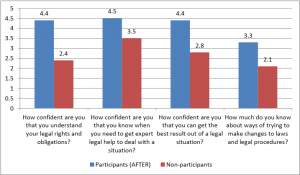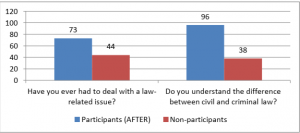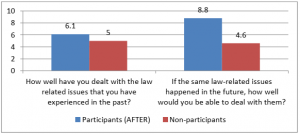January 2013
| Report: | Legal Capability for Everyday Life Evaluation Report |
| Report commissioned by: | Lisa Wintersteiger, Law for Life |
| Report author: | Liz Mackie, The Gilfillan Partnership |
Indicator 10: How confident are you that you can get the best result out of a legal situation?
Participants were asked to rate their confidence in understanding their legal rights and obligations on a scale from Not at all confident to Very confident. A response of Not at all confident has been given a score of 1 and Very confident has been given a score of 5. Higher scores represent increased levels of confidence, with 5 being the maximum confidence score. The average rating for this indicator before the course took place was 2.9. The average rating at the end of the course was 4.4. This represents an increase of 52 per cent in the average confidence rating for participants over the programme period, demonstrating that the course increased participants’ confidence to feel that they could now get the best result out of a legal situation.
Indicator 11: Do you agree with this statement: “I am good at taking action and seeing things through to the end”?
Participants were asked to rate how strongly they agreed with this statement on a scale from Strongly disagree to Strongly agree. A response of Strongly disagree has been given a score of 1 and Strongly agree has been given a score of 5. Higher scores represent greater agreement with the statement, with 5 being the maximum agreement score.
The average rating for this indicator before the course took place was 3.7. This increased to 4.4 by the end of the course. Even before the course began, the most frequent response to this question was Strongly agree; 32 per cent of respondents strongly agreed that they are good at taking action and seeing things through to the end. By the end of the course, over half of the participants (53%) strongly agreed with this statement. After completing the course, 91 per cent of participants either agreed or strongly agreed with this statement, compared with 58 per cent before taking part in the course.
Indicator 12: Do you agree with this statement: “I am well-organised and can easily find relevant paperwork and correspondence when I need it.”?
Participants were asked to rate how strongly they agreed with this statement on a scale from Strongly disagree to Strongly agree. A response of Strongly disagree has been given a score of 1 and Strongly agree has been given a score of 5. Higher scores represent greater agreement with the statement, with 5 being the maximum agreement score.
The average rating for this indicator before the course took place was 3.6. This increased to 4.0 by the end of the course. The most frequent response before the course took place was Agree; 32 per cent of participants agreed that they were well organised and could easily find relevant paperwork and correspondence. By the end of the course, the most frequent response was Strongly agree, with 41 per cent of participants strongly agreeing with this statement. After completing this course, 75 per cent of participants either agreed or strongly agreed with this statement, compared with 58 per cent before taking part in the course.
Domain 4: Engaging and influencing
Indicator 13: How much do you know about ways of trying to make changes to laws and legal procedures?
Participants were asked to rate their knowledge on a scale from Nothing at all to A great deal. A response of Nothing at all has been given a score of 1 and A great deal has been given a score of 5. Higher scores represent increased levels of knowledge about ways of trying to make changes to laws and legal procedures, with 5 as the maximum score.
The average rating for this indicator before the course took place was 1.9. This increased to 3.3 at the end of the course. This represents an increase of 74 per cent in the average rating for this indicator. The most frequent response from participants before the course took place was Not very much, with around half the participants (52%) giving this response. By the end of the course, the most frequent response was Some, with 38 per cent of participants giving this response.
Before the course took place, only 13 per cent of participants gave a positive response to this question (by answering either A great deal, Quite a lot, or Some). After taking part in the course, 78 per cent of participants gave a positive response to this question.
Comments from participants
The participants’ written comments about the course were all very positive. Participants commented that since being on the course they knew more about legal issues and felt more confident to use this knowledge in everyday situations. The following comments are typical:
‘[I learned about] my consumer rights, where to go for advice, what to provide in the way of evidence to pursue a claim and to be resilient (or should that be persistent?)!’ [Attend participant]
‘The most useful thing that I learned from the course was about housing, mean landlords, tenancy agreements and about benefits. This course was excellent and very useful for all of us and the course delivery was very good. I really enjoyed the course and learned very much.’ [Paiwand participant] ‘The most useful thing I’ve learned is about the law. I still don’t know what will happen in the future but I learned something from this course. It was very helpful for me.’ [Paiwand participant]
‘The course has helped me to know my rights and to find out my options concerning anything.’ [Community Links participant]
Participants were also asked if there was anything about the course that they felt could have been improved. Eight participants made suggestions; four said that they would have liked the course to include more sessions, and a further three would have liked specific areas of law to have been covered in more depth (benefits and housing). One suggested improvement related to the noisiness of the training venue.
Comparing the legal capability of project participants and non-participants Partner organisations were asked to identify a control group for this evaluation. The control group should resemble the participant group (i.e. service users of the partner agency) but would not be taking part in the PLE course. In total, we received 22 completed questionnaires from non participants (12 from Attend and 10 from Community Links); six were completed before the courses started and 16 completed after the courses had ended. Because only six matched before and after questionnaires were completed (by the Attend control group) it is not possible to make and comparisons in the before and after legal capability of the nonparticipants.
To compare legal capability of project participants and non-participants, the 16 control group questionnaires completed after the courses ended are used. This small sample enables us to make some comparisons between the legal capability of people with a shared characteristic (i.e. service users of the advice agencies participating in this project) where some have participated in PLE and others have not.
For 12 of the 13 legal capability indicators, the average responses from the nonparticipants are similar to the average before responses of the participants. The exception is for indictor 8 which asks how well the respondent has dealt with law related issues that they have experienced in the past. On this indicator, the average rating from the non-participants is significantly lower than the average before rating of the participants. This difference is explained by the bias towards higher ratings for the participant group from the Paiwand participants, as discussed above. In general, then, the average responses from the non participants are very similar to the average before responses from the participants. That is, all those who completed a questionnaire at a time when they had not taken part in PLE showed the same levels of legal capability on virtually all indicators. Comparing the non-participants responses to the after responses of participants shows that the legal capability of participants was significantly higher. The comparisons for key indicators are shown in the charts below. These illustrate that people who took part in the PLE courses are more confident that they understand their legal rights and obligations, that they know when to get expert legal help, and that they can get the best results out of a legal situation.
Importantly, people who participated in the PLE courses are far more likely to recognise that they have already dealt with a law-related issue, demonstrating that they have become better able to recognise the legal dimensions of everyday issues. Chart III illustrates that while there is a small difference between participants and non-participants in how well they have dealt with law-related issues in the past (a difference that is due to the higher ratings on this indicator from the Paiwand participants), there is a substantial difference between participants and nonparticipants in how they feel they would deal with law-related issues in the future.
The PLE participants consider themselves far better able than non-participants to deal with law-related issues in the future.
Chart I: Responses for participants and non-participants for key indicators (average response ratings where highest rating = 5)
Chart II: Responses for participants and non-participants for key indicators (% answering YES)
Chart III: Responses for participants and non-participants for key indicators (average response ratings where highest rating = 10)



